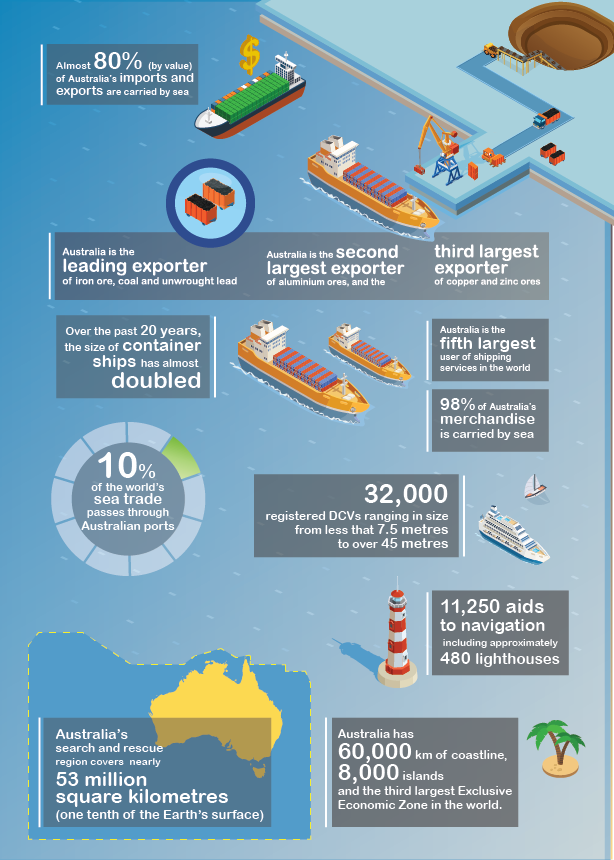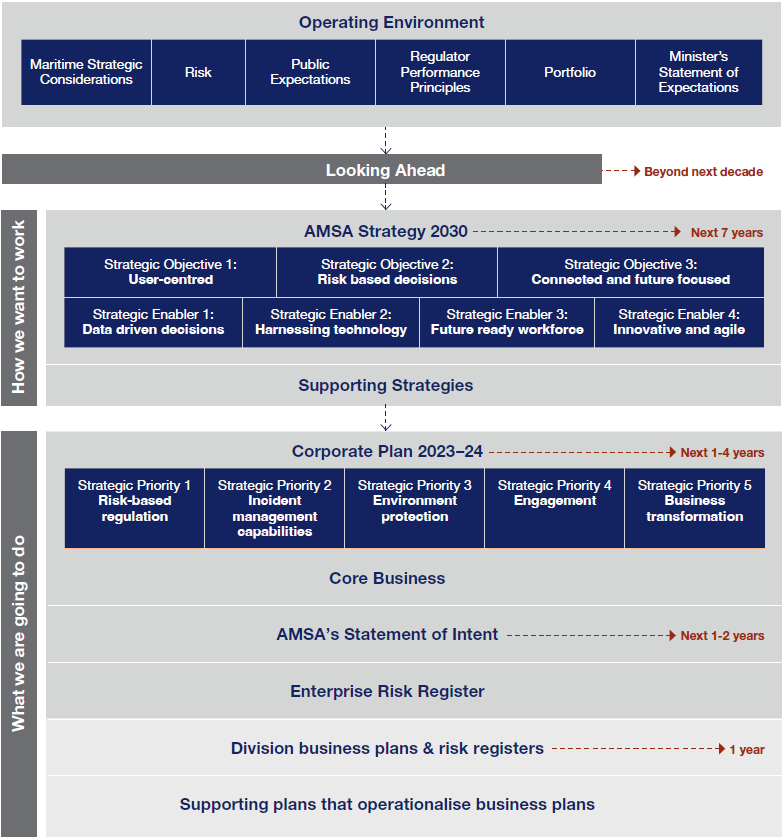1.1 Operating environment
With more than 99 per cent of Australia’s international trade carried by sea, Australia has one of the largest shipping tasks in the world:
- more than 30,000 port calls by 6,315 uniquely identified trading ships in 2020–213
- an Australian trading fleet of approximately 130 vessels with a carrying capacity of 6.6 million tonnes.4
Given the size of the task it is important that Australia maintains an influence in the development of international standards to ensure vessels visiting Australian waters are safe, and their environmental impacts are minimised.
At a national level, Australia’s domestic commercial fleet is made up of around 32,000 vessels ranging in size from less than 7.5 metres to over 45 metres. These vessels operate across a range of industry sectors, from hire and drive vessels such as kayaks used for recreational purposes, to barges and passenger ferries, as well as fishing vessels that range from small dinghies right up to large trawlers. This tremendous diversity accounts for the disparate safety cultures and divergent attitudes towards regulation across the fleet.
Domestic and international ships in Australian waters operate in some of the world’s most ecologically sensitive sea areas. AMSA has a duty to protect these sensitive marine ecosystems from ship–sourced pollution through effective regulation and compliance activities, underpinned by international conventions. We also play a key role in the maintenance of a national, integrated government and industry framework that is capable of effective responses to pollution incidents in the marine environment.
AMSA is Australia’s search and rescue (SAR) coordination authority. Our operations cover approximately 53 million square kilometres, or 10 per cent of the Earth’s surface, extending into the Indian, Pacific and Southern Oceans. Given the breadth of AMSA’s remit, the efficacy of our SAR operations relies on strong and effective cooperation with all Australian jurisdictions and keeping pace with the advancement of distress alerting technologies.
Australia has 60,000 kilometres of coastline and 8,000 islands. Our nation has the third largest exclusive economic zone in the world. To ensure that all vessels can safely operate as they travel through these expansive waters, AMSA maintains an aids to navigation network of some 470 visual and electronic aids. States and territories also maintain some aids to navigation used by international shipping.
As a Commonwealth entity AMSA is required to implement whole of government policies. APS Net Zero 2030 is the Australian Government’s policy for the Australian Public Service (APS) to reduce its greenhouse gas emissions to net zero by 2030, and transparently report on its emissions from the latter half of 2023. AMSA will apply this framework as far as practicable for our operations.
The diversity of AMSA’s operations mean that our operating and regulatory environment is highly complex and constantly evolving. We need to be ready to respond to the effects of changes to maritime trade, climate, the ramifications of new technologies in the maritime industry and within governments, or to any of the many other changes affecting our operating environment.

1.2 Government direction
At a high level, AMSA contributes to one Outcome and one Program, which is divided into two subprograms:
Outcome 1—Minimise the risk of shipping incidents and pollution in Australian waters through ship safety and environment protection regulation and services and maximise people saved from maritime and aviation incidents through search and rescue coordination.
- Program 1.1—Seafarer and ship safety, environment protection and search and rescue.
- Sub-program 1.1.1—Seafarer and ship safety and environment protection aims to minimise the risk of shipping incidents and pollution in Australian waters through ship safety and environment protection regulation and services.
- Sub-program 1.1.2—Search and rescue aims to maximise the number of people saved from maritime and aviation incidents through coordinating search and rescue.
AMSA’s performance is measured at the Portfolio level via three Portfolio Budget Statement (PBS) measures, see Part 2 for further detail.
1.3 Statement of Intent
Our Statement of Intent5 outlines AMSA’s approach to achieving our goals and responds to the Minister’s Statement of Expectations (November 2021). It reaffirms AMSA’s commitment to our legislated purpose and outlines our strategic priorities, including taking a modern, risk-based approach and collaborating with our stakeholders in delivering our regulatory functions.
1.4 Regulator performance principles
As a regulator we are required to demonstrate our performance against the three principles of regulator best practice described in the Regulator Performance Guide (June 2021) (RPG). The strategic priority tables demonstrate alignment with these principles (see Part 2).
As a regulator we are required to demonstrate our performance against the three principles of regulator best practice described in the Regulator Performance Guide (June 2021) (RPG). The strategic priority tables demonstrate alignment with these principles (see Part 2).
Principle | Description |
#1. Continuous improvement and building trust | Regulators adopt a whole-of-system perspective, continuously improving their performance, capability and culture to build trust and confidence in Australia’s regulatory settings. |
#2. Risk based and data driven | Regulators manage risks proportionately and maintain essential safeguards while minimising regulatory burden and leveraging data and digital technology to support those they regulate to comply and grow. |
#3. Collaboration and engagement | Regulators are transparent and responsive communicators, implementing regulations in a modern and collaborative way. |
1.5 Looking Ahead
To ensure AMSA is anticipating and ready for its future, our internal environmental scan document, Looking Ahead, outlines how our operating environment is likely to evolve, identifying the major challenges and opportunities that we are likely to experience over the coming decades.
1.6 Strategy 2030
Our Strategy 2030 sets out how we want to work to deal with the challenges and opportunities we are likely to face during the decade.

1.7 Corporate Plan
This Corporate Plan considers our operating environment, our Strategy 2030 and responds to the expectations set by our Minister and the Regulator Performance Guide (June 2021). Core components of the Corporate Plan are:
Strategic priorities
Using the strategic objectives and enablers from Strategy 2030 as a filter, the Corporate Plan details five strategic priorities to guide our work.
- Risk-based regulation: our actions and interventions as a safety regulator must be proportionate to the risk being managed and should not unnecessarily impede the efficient operations of those we regulate. Improving safety of navigation, seafarers and vessels must be at the core of what we do. We also need to make sure that we are anticipating and planning for new industries operating in the maritime environment, for example offshore wind farms, whilst continuing our traditional role of ensuring safety of navigation.
- Incident management capabilities: we want to take full advantage of improving capability in the areas of search and rescue and environmental incident response by investing in our people and integrating new systems and technologies into our existing capabilities.
- Environment protection: the IMO has agreed goals that will significantly reduce greenhouse gas emissions
from international shipping. Australia has committed to these emission reductions and AMSA will be engaged in
their implementation for many years to come. Broader environmental impacts from shipping and a changing risk
landscape due to alternative fuels as the industry decarbonises will also be a focus. - Engagement: our stakeholder engagement is a critical element of our business. We engage with a diverse range of domestic and international stakeholders on a variety of issues, including seeking and receiving feedback, communicating regulatory and compliance issues, raising awareness and educating, shaping outcomes, delivering services, and coordinating responses, or other activities. It’s crucial that all our communication and engagement activities are effective, that is, coordinated, targeted, customised and fit-for-purpose. Our multilateral international engagement aims to shape global standards and agreements to meet Australia’s maritime interests. Our engagement with our bilateral partners serves two purposes: to collaborate to share information, knowledge and technology; and to work with key partners to help build their capability and resilience in maritime safety, environment pollution response, and search and rescue.
- Business transformation: our organisation – its systems, processes, and people, must continue to evolve to meet government and community expectations. Our technology infrastructure and data management must keep pace with the rate of change in our regulated community and meet its demand for digital service delivery. As a government regulator we need to be vigilant with our service delivery transactions and utilise the data we collect to make evidence-based and risk-based decisions. Ensuring our people have the capability and capacity to deliver our core business and support business transformation is pivotal to realising AMSA’s Strategy 2030. To ensure our business transformation priorities maximise the benefits to both AMSA and our regulated community, we have established a Portfolio Board and Program Boards to ensure investment is being made in the right areas and there is appropriate oversight to achieve our strategic goals.
Initiatives
The initiatives grouped under the strategic priorities detail what we will be doing over the next four years in pursuit of our strategic objectives, including significant programs and projects, with a specific focus on 2023–24.
New capabilities to be delivered are identified by the capability icon. ![]()
Where appropriate, the strategic priority tables demonstrate alignment with achievement of AMSA’s Strategy 2030 (see page 12) and the three principles of the Regulator Performance Guide (see page 11).
Risk
Our risk management policy, framework and guidelines are aligned with better practice methodologies and consistent with the international standard on risk management (ISO 310000:2018) and the Commonwealth Risk Management Policy (CRMP) 2023 which took effect on 1 January 2023. Our key enterprise risks are described under the relevant strategic priority and include key controls. Many of the initiatives described under the strategic priorities are future risk treatments. Our complete list of enterprise risks is included at Appendix 1.
AMSA participated in the 2023 Comcover Risk Management Benchmarking Survey, which is a self-assessment tool to measure our risk management capability. Findings from the Survey will be incorporated into the risk maturity roadmap to further develop our risk management practices.
The risk appetite and tolerance range is indicated by the width and placement of the bar within the coloured arrow. The red end is low, and the green, high.
Ethics
AMSA has wide range of interventions and controls that individually and collectively influence culture and the way we work. Guided by our values, systems such as confidential reporting, risk management, training and awareness, and our integrated management system all contribute to embedding a culture of ethical behavior.
Non-financial performance measures
In addition to reporting on our financial performance we are required to report against performance at an outcome level and measure the achievement of our purpose and vision – safe and clean seas, saving lives. We also include some measures that demonstrate our performance against the three principles of regulator best practice described in the Regulator Performance Guide (June 2021).
Core business
Organised by the component parts of our vision; (1) safe seas, (2) clean seas, (3) saving lives; our Plan-on-a-Page (PoaP) (see page 28) provides a summary of our strategic priorities, key activities6 and the supporting core business that together deliver our purpose and the outcome, programs and sub-programs detailed in our portfolio budget statements.
Footnotes
3 Source: Bureau of Infrastructure and Transport Research Economics (BITRE) 2023, Australian sea freight 2020–21, Canberra, ACT
4 The number of major (deadweight tonnage greater than 2,000 tonnes) active Australian registered ships with a General Licence decreased by two to 11 as of 30 June 2021.
5 https://www.amsa.gov.au/about/corporate-publications/ministers-statement...
6 Our key activities are objects of the AMSA Act and constitute AMSA’s operational core business to deliver the sub-programs, program, and outcome detailed in our portfolio budget statements. Unless there have been changes to legislation, machinery of government or programs, these activities are generally not subject to change.